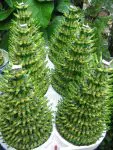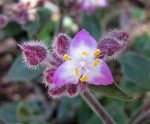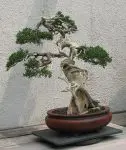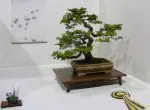This post contains affiliate links. If you buy something from one of our links we may earn a commission. Thanks
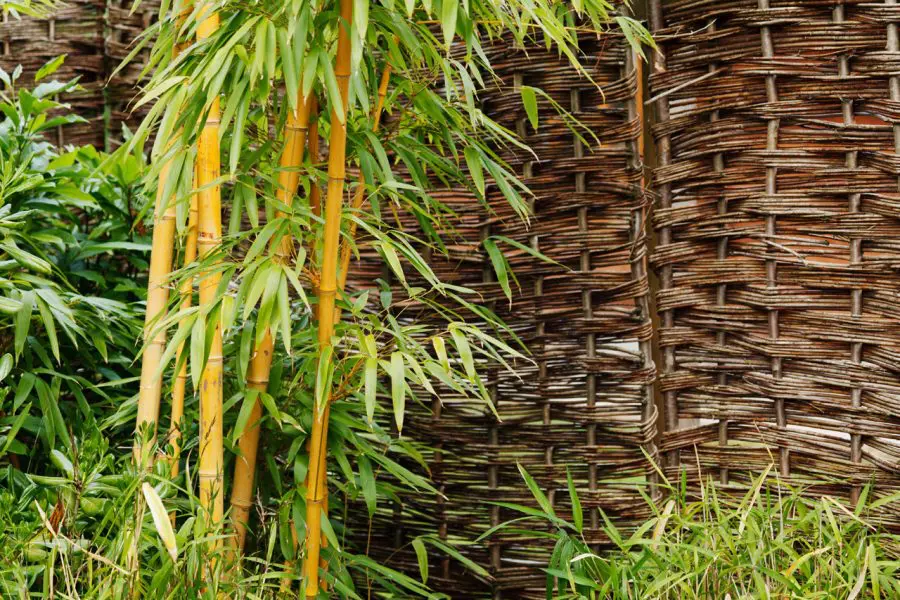
Discover the secrets to keeping your bamboo plants thriving indoors with our comprehensive guide to bamboo plant indoor care. Get your green thumb on today!
Bamboo plant indoor care is straightforward. Place the plant in bright, indirect light and keep the soil consistently moist, but not waterlogged. Fertilize with a balanced liquid fertilizer every 4-6 weeks. Avoid exposure to drafts or sudden temperature changes for optimal growth.
Welcome to the wonderful world of bamboo plant indoor care!
Growing bamboo indoors is not only a beautiful and natural way to decorate your home, but it’s also a fun and rewarding hobby.
Whether you’re an experienced green thumb or a newbie to the world of plants, we’ve got you covered with all the tips and tricks you need to keep your indoor bamboo plants thriving.
So, get ready to bring a touch of nature into your home with our comprehensive guide to bamboo plant indoor care!
Bamboo Plant Indoor Care Introduction
Hey there! Are you looking to add a little bit of greenery to your home or office?
Look no further than bamboo plants! Not only are they stunning to look at, but they’re also easy to care for and bring a sense of calm to any space.
However, caring for bamboo plants indoors can sometimes be a little tricky.
That’s where we come in! In this guide, we’ll cover everything you need to know about bamboo plant indoor care, from choosing the right type of bamboo plant to troubleshooting common issues.
So, let’s get started on your journey to becoming a bamboo plant pro!
Benefits of Growing Indoor Bamboo
When most people think of bamboo, they imagine tall, swaying stalks in a tropical forest. However, bamboo is actually an incredibly versatile indoor plant that can thrive indoors as well.
Here are just a few of the benefits of growing bamboo indoors:
• Air purification: Bamboo plants are natural air purifiers, meaning they can help remove harmful toxins from your indoor environment.
• Aesthetic appeal: Bamboo plants come in a variety of shapes, sizes, and colors, making them a great addition to any home decor.
• Stress relief: Research has shown that simply being around plants can help reduce stress and promote a sense of calm.
• Low maintenance: Unlike some other houseplants, bamboo plants are relatively low maintenance and can thrive with minimal attention.
Brief Overview of Topics Covered
In this blog post, we’ll cover everything you need to know to keep your indoor bamboo plants happy and healthy.
We’ll start by discussing the different types of bamboo plants that are suitable for indoor growing, and their unique characteristics and requirements.
Next, we’ll cover lighting, watering, and humidity – three key factors in bamboo plant care.
We’ll also talk about soil and fertilization, as well as pruning and propagation techniques.
Finally, we’ll discuss common problems that can arise when caring for bamboo plants indoors and offer solutions to address them.
By the end of this guide, you’ll be well on your way to becoming a bamboo plant care pro!
Bamboo and Feng Shui: Creating Harmony in Your Home
In recent years, the ancient Chinese practice of feng shui has become increasingly popular in the Western world.
Feng shui is the art of arranging your environment in a way that promotes harmony and balance in your life.
It is believed that the placement of objects, colors, and shapes in your living space can affect your well-being, relationships, and success.
Bamboo is a popular plant in feng shui, as it is believed to bring good fortune, prosperity, and positive energy into your home.
Types of bamboo plants suitable for indoor care
Not all bamboo plants are created equal, and that’s especially true when it comes to indoor growing and bamboo plant indoor care.
Some bamboo species are better suited for life inside, while others require more space and sunlight than most indoor environments can provide.
In this section, we’ll take a closer look at the types of bamboo plants that are best suited for indoor care, and what makes them unique.
So whether you’re looking for a small and compact bamboo plant to adorn your windowsill or a larger statement piece for your living room, we’ve got you covered!
Types of Bamboo Plants Suitable for Indoor Growing
When it comes to bamboo plants suitable for indoor growing, there are a few species that stand out.
Here are the three most popular types of bamboo plants for indoor growing:
Dwarf Bamboo: As the name suggests, dwarf bamboo is a small variety of bamboo that’s perfect for indoor growing.
It typically reaches a maximum height of 2-4 feet and is well-suited for small spaces.
Lucky Bamboo: The lucky bamboo common name is misleading because it is not actually bamboo, but rather a popular houseplant plant known as Dracaena sanderiana.
It’s a popular choice for indoor growing due to its unique appearance and low maintenance requirements. They are tropical plants and not cold hardy.
Bamboo Palm: While not technically a bamboo plant, the bamboo palm gets its name from its bamboo-like appearance.
It’s a larger plant than the other two types mentioned, but it’s well-suited for indoor growing due to its adaptability to low-light conditions.
Characteristics and Requirements of Each Type of Bamboo Plant
Each type of bamboo plant has its own unique set of characteristics and requirements.
Here are some key things to keep in mind when for providing each type of bamboo plant indoor care:
Dwarf Bamboo: Dwarf bamboo prefers bright light and thrives in warm and humid environments. It’s important to keep the soil moist but not waterlogged and to fertilize the plant every few months.
Lucky Bamboo: Lucky bamboo can be grown in soil or water and prefers bright, indirect sunlight.
It’s important to change the water frequently if growing in water and to fertilize the plant every few weeks. Read more about growing Lucky Bambo in water or soil.
Bamboo Palm: (Chamaedorea seifrizii) Bamboo palms prefer low to moderate light conditions and well-draining soil. Read more about Bamboo Palms
They should be watered regularly, but care should be taken not to overwater the plant. Fertilization is important during the growing season.
Bamboo-like plants are worth growing indoors too
In addition to traditional bamboo plants, there are a couple of other bamboo-like plants that are worth considering for indoor growing: lucky bamboo and heavenly bamboo.
Lucky bamboo, which is actually a member of the lily family, is a popular choice for indoor growing due to its striking appearance and low maintenance needs.
Lucky bamboo is often sold in small, ornamental arrangements and can be grown in just water or in soil.
It’s a great choice for those who want the look of bamboo without the height or space requirements.
Heavenly bamboo, on the other hand, is a shrub that gets its name from its resemblance to bamboo, but is not actually related.
It’s known for its vibrant, evergreen foliage and is a great choice for those looking for a larger statement plant.
Heavenly bamboo is also relatively low maintenance, making it a great choice for indoor growing.
Both lucky bamboo and heavenly bamboo offer unique benefits for indoor growing and can be a great way to add a touch of natural beauty to your home or office.
Even though are not even true bamboo plants although they are still worth growing. Read about 20 Benefits Of Keeping Indoor Plants
Our Top Picks For Bamboo Plant Indoor Care
Black Bamboo Plants(Phyllostachys nigra)
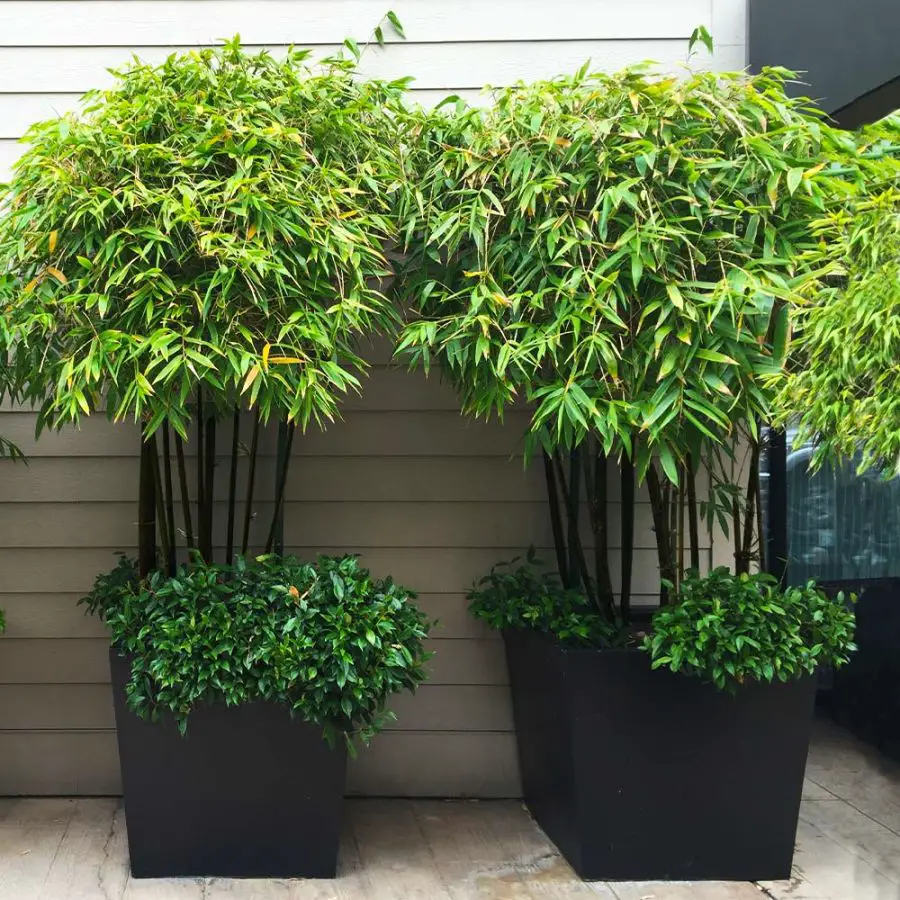
The Black Bamboo plant, scientifically known as Phyllostachys nigra, is a highly desirable choice for both indoor and outdoor gardening due to its unique and fast-growing nature. With its low-maintenance qualities, it’s an ideal option for beginner gardeners who are looking for an easy-to-care-for plant.
One of the most notable features of the Black Bamboo is its incredible hardiness. It can withstand extremely low temperatures, surviving in temperatures as low as 0 degrees Fahrenheit. This makes it one of the most resilient varieties of bamboo and a popular choice for gardeners in colder regions. It can be grown in pots as an outdoor plant and moved indoors during the winter months.
In addition to its resilience, Black Bamboo is also renowned for its striking appearance. The shoots start off green but turn a flat black color in their second year, providing a unique and eye-catching contrast to its deep green foliage. It can serve as a central part of home decor or as a focal point in any garden.
The Black Bamboo is also a rapid and robust grower, typically growing between 10-12 feet per year and eventually reaching a height of 25 feet. Its growth is easy to manage, and it can be trimmed to a desired height.
Many gardeners choose to plant several Black Bamboo plants 3-5 feet apart to create a privacy screen.
Overall, the Black Bamboo plant is a fantastic addition to any garden or home, offering both resilience and aesthetic appeal. With all it has going for it it is a great candidate for bamboo plant indoor care.
Read more about Black Bamboo
Multiplex Bamboo (Bambusa Glaucescens ‘Alphonso Karr’)
The Multiplex Bamboo, scientifically known as Bambusa Glaucescens ‘Alphonso Karr’, is an excellent option for those seeking a tropical feel and easy growth without the hassle of invasiveness.
This cold hardy, sub-tropical bamboo is capable of thriving in temperatures as low as 10 degrees Fahrenheit, making it a resilient option for a variety of climates. It prefers bright light and moist soil.
Often referred to as the Hedge Bamboo or Clumping Bamboo, the Multiplex grows at a rapid pace, forming a dense living wall that can reach heights of up to 30 feet in less than two years.
This fast growth, combined with its versatile nature, makes it a great option for creating an exotic privacy fence or planting in a container on a patio.
Its dense, clumping growth makes it ideal for hedging along borders, driveways, and other areas, without the risk of invasiveness.
The yellowish-green Multiplex bamboo is perfect for creating a secluded, island-inspired retreat no matter where it’s grown.
Maintaining your desired height is easy with annual pruning, meaning you won’t have to continuously trim your bamboo to achieve your desired look.
Additionally, the Multiplex is drought-tolerant, requiring little watering, as rain takes care of most of its watering needs.
In summary, the Multiplex Bamboo is a fantastic choice for those looking for a tropical feel with easy growth and versatility.
Its non-invasiveness and cold-hardy nature make it an excellent option for a variety of climates, while its rapid growth and dense, clumping nature make it ideal for creating unique and secluded retreats. Read more about Multiplex Bamboo.
Fernleaf Bamboo (Bambusa multiplex ‘Fernleaf’)
Looking for a unique and low-maintenance plant to add tropical vibes to your yard or even indoors?
Look no further than the Fernleaf Bamboo, a variety of the Multiplex Bamboo plant.
The Fernleaf Bamboo features graceful, thin canes that gather at the base of the plant and produce long, slender, fern-like foliage.
The full branches create a voluminous canopy that offers privacy, shade, and a touch of the tropics, no matter where you plant it.
This compact and clumping bamboo variety offers fast-growing color without the hassle of maintenance.
It thrives in almost any condition, including tough urban soil, and becomes hardy and drought-tolerant once established.
Additionally, it responds well to trimming, making it easy to maintain the perfect height and shape.
When fully mature, the Fernleaf Bamboo reaches a height of just 6-10 feet and a width of 4-6 feet, making it perfect for easy privacy in yards or on patios, or even planted in containers for indoor use.
And the best part? As a clumping variety, it’s less likely to spread where it’s not wanted, ensuring that it stays contained and easy to manage.
Overall, the Fernleaf Bamboo is a fantastic choice for those looking for a low-maintenance and unique tropical hedge.
So why wait? Add some Fernleaf Bamboo to your space today and enjoy the beauty and ease of this stunning plant. Read more about Fernleaf Bambo.
Bamboo plant myths
Hey there! Have you ever heard myths about bamboo plants?
Many people have misconceptions about these plants, and it’s time to set the record straight.
In this blog post, we’ll debunk some common bamboo plant myths and give you the right information to properly care for your indoor bamboo garden.
Let’s get started!
There are many myths and misconceptions surrounding bamboo plants, such as the idea that they are invasive or that they require constant watering.
You could probably write a book debunking some of these common myths and setting the record straight on how to properly care for indoor bamboo plants.
Common myths and misconceptions about bamboo plants
Bamboo plants are beloved for their unique and exotic appearance, as well as their ease of care.
However, there are many myths and misconceptions surrounding these plants that can make bamboo plant indoor care for them confusing.
In this section, we’ll debunk some of the most common bamboo myths and set the record straight on how to properly care for your indoor bamboo plants.
Debunking bamboo myths – Bamboo is invasive
One of the most persistent myths about bamboo plants is that they are invasive and will take over your garden or home.
While it is true that some species of bamboo can be quite aggressive, there are many non-invasive varieties that can be safely grown indoors. Some popular non-invasive species include lucky bamboo and dwarf bamboo.
Bamboo requires constant watering
Another myth about bamboo plants is that they require constant watering and high water levels to thrive.
While it is true that bamboo plants require regular watering, they do not need to be watered every day.
In fact, overwatering can be detrimental to the plant’s health.
A good rule of thumb is to water your bamboo plant once a week, or when the top inch of soil feels dry to the touch.
Bamboo plants are hard to care for
Finally, some people believe that bamboo plants are difficult to care for and require a lot of maintenance.
In reality, bamboo plants are relatively low-maintenance and can thrive with minimal attention.
With proper watering, occasional fertilization, and the right amount of light, your indoor bamboo plant can live for many years.
Setting the record straight on bamboo care
Now that we’ve debunked some common bamboo myths, it’s important to understand the proper care for indoor bamboo plants.
In general, bamboo plants prefer bright, indirect sunlight and should be kept in a well-draining pot with a good-quality potting mix.
They should be watered regularly, but not overwatered, and fertilized every few months with a balanced fertilizer.
Proper bamboo plant indoor care
By understanding the truth about bamboo myths and properly caring for your indoor bamboo plant, you can enjoy the beauty and benefits of these unique plants without any confusion or frustration.
Remember to choose a non-invasive variety, water your plant once a week, and give it plenty of bright, indirect sunlight, and you’ll have a happy and healthy bamboo plant for years to come.
How To Grow Bamboo Indoors
Hey there, green thumbs! Are you tired of the same old houseplants that just sit there and look pretty?
If you’re looking to add a little more excitement to your indoor garden, you might want to consider adding some bamboo.
Not only is bamboo incredibly easy to care for, but it’s also super stylish and trendy.
Whether you’re looking to create a zen-inspired oasis or just want to add a little green to your living space, growing bamboo indoors is the perfect way to spruce up your home décor.
So, let’s get started on this exciting new plant adventure together!
Light requirements for bamboo plants
Bamboo plants are known for their love of sunlight, but did you know that not all types of bamboo plants require the same amount of light?
In fact, indoor bamboo plants have specific light requirements that can make all the difference when it comes to their health and growth.
In this section, we’ll explore the different light requirements for bamboo plants and offer tips on how to ensure your bamboo thrives in its indoor environment.
Whether you have a bright and sunny windowsill or a darker corner of your home, we’ve got you covered!
Ideal Lighting Conditions for Bamboo Plants
Bamboo plants require a certain amount of light to grow and thrive.
While some types of bamboo plants can tolerate lower light conditions, all types benefit from bright, indirect sunlight.
Ideally, bamboo plants should receive 6-8 hours of sunlight per day.
Strategies for Providing Adequate Light in Indoor Settings
Providing adequate light for your indoor bamboo plants can be a challenge, especially if you don’t have access to a lot of natural light.
Here are a few strategies for ensuring your bamboo plants get the light they need:
Place your bamboo plant near a bright, sunny window. South-facing windows are ideal for providing the most light, but any window that receives at least 6 hours of sunlight per day should be sufficient.
Use artificial lighting. If you don’t have access to natural light, or if the light in your home is not sufficient, you can use artificial lighting to supplement your bamboo plant’s needs.
LED grow lights are a great option for indoor bamboo plants, as they provide the right spectrum of light and are energy efficient.
Rotate your plant. If your bamboo plant is not getting enough light from its current location, try rotating it every few days to ensure that all sides of the plant receive adequate light.
Common Problems Related to Lighting
If your bamboo plant isn’t getting enough light, you may notice a few common problems.
The leaves may turn yellow and drop off, or the plant may become leggy and thin.
On the other hand, if your bamboo plant is getting too much light, the leaves may become scorched or discolored.
It’s important to monitor your plant regularly and adjust its lighting conditions as needed to ensure that it stays healthy and vibrant.
Choosing the right container
Are you considering starting an indoor bamboo garden but feeling a little overwhelmed by all the different container options out there?
Don’t worry – choosing the right container for your bamboo plant is an important decision, but it doesn’t have to be a stressful one.
In this post, we’ll cover the pros and cons of different types of containers, and offer tips on factors like drainage, pot size, and soil mix to consider when making your decision.
With a little bit of knowledge, you’ll be able to choose the perfect container for your indoor bamboo plant in no time!
Choosing the right container:
The container you choose for your bamboo plant can have a big impact on its growth and health.
Here’s a section on the different types of containers available, and the pros and cons of each.
We will also cover topics like drainage, pot size, and choosing the right soil mix.
Importance of choosing the right container
Choosing the right container for your bamboo plant is an important part of keeping it healthy and thriving.
The container you choose can affect everything from how much water your plant gets to how much room its roots have to grow.
In this section, we’ll go over the different types of containers available, the factors you should consider when choosing a container, and the pros and cons of each type.
Types of containers available
There are many different types of containers available, and each has its own unique advantages and disadvantages.
Plastic containers are lightweight and inexpensive, making them a popular choice for many indoor gardeners.
Terracotta and ceramic containers are more decorative and can help regulate moisture levels, but they can be heavier and more fragile.
Bamboo containers are a more eco-friendly option, but they may not be as durable as other materials.
Factors to consider when choosing a container
When choosing a container for your bamboo plant, there are several factors you should consider.
One of the most important is drainage, as bamboo plants can be sensitive to overwatering.
Make sure the pot you choose has a drainage hole in the bottom of the pot.
You’ll also want to choose a pot size that is appropriate for your plant’s current size and growth rate, and make sure to use a soil mix that provides adequate nutrients and drainage.
Pros and cons of different container types
Each type of container has its own pros and cons.
Plastic containers are lightweight and easy to clean, but they may not be as aesthetically pleasing as other materials.
Terracotta and ceramic containers are more decorative and can help regulate moisture levels, but they can be more expensive and may require more maintenance.
Bamboo containers are eco-friendly and biodegradable, but they may not last as long as other materials and may not be as sturdy.
Reap: Choosing the right container for your bamboo plant
Choosing the right container for your bamboo plant is an important part of keeping it healthy and thriving.
By considering factors like drainage, pot size, and soil mix, you can help ensure that your plant has the right conditions to grow and thrive.
Whether you choose a plastic, terracotta, ceramic, or bamboo container, be sure to select one that meets your needs and fits your personal style.
Watering and humidity
When it comes to providing bamboo plant indoor care your bamboo tree is just like any other houseplant, bamboo plants require proper watering and humidity to thrive.
However, the specific watering and humidity requirements for bamboo plants can be a bit trickier to master, especially if you’re new to indoor gardening.
In this section, we’ll dive into the ins and outs of watering and humidity for bamboo plants, offering tips and tricks to keep your plant healthy and happy.
So grab your watering can and let’s get started!
Importance of Proper Watering and Humidity for Bamboo Plants
Bamboo plants require a certain level of moisture to grow and thrive, but it’s important to strike the right balance.
Overwatering or underwatering can lead to a host of problems, including root rot, yellowing leaves, and even plant death.
In addition to proper watering, bamboo plants also benefit from high humidity levels, which can be a challenge in some indoor environments.
Strategies for Maintaining Appropriate Moisture Levels
To ensure your bamboo plant gets the right amount of water and humidity, it’s important to follow a few key strategies. These include:
• Water your plant only when the top inch of soil is dry. Avoid overwatering, which can lead to soggy soil and root rot.
• Providing additional humidity by misting your plant regularly, using a humidifier, or placing a tray of water near the plant is a good idea.
• Using a well-draining soil mix that allows excess water to drain away from the roots.
Signs of Overwatering and Underwatering
Overwatering and underwatering can have similar symptoms, making it difficult to determine which issue is affecting your bamboo plant.
Signs of overwatering include yellow leaves, mushy stems, and a foul odor.
Signs of underwatering include crispy brown leaves and dry, crumbly soil.
Regularly checking the soil moisture level and adjusting your watering habits as needed can help prevent these issues.
Avoiding the Use of Tap Water
Tap water can contain chlorine, fluoride, and other chemicals that can be harmful to bamboo plants.
To avoid these issues, consider using filtered or distilled water instead for the best results. You can also use bottled water or rainwater.
Can bamboo be grown in water?
Bamboo can be grown in water, but it depends on the species of bamboo and the conditions in which it is grown.
Some bamboo species can grow well in water, while others prefer well-drained soil.
In general, bamboo prefers moist soil, but excessive water can lead to root rot and other problems.
It is also possible to propagate bamboo by rooting cuttings in water.
Simply place the cuttings in a container filled with water and change the water frequently until roots develop.
Once the roots are established, the bamboo can be planted in soil.
Overall, bamboo can be grown in water, but it requires careful attention to ensure that the plant is healthy and thriving.
Is lucky bamboo grown in water?
Lucky Bamboo (Dracaena sanderiana) is typically grown in water.
It is a popular houseplant that is often grown in a container filled with water and pebbles or decorative rocks.
The plant is commonly sold as a small arrangement of stalks that have been trained into interesting shapes or braided together.
To grow Lucky Bamboo in water, the stalks should be placed in a container filled with distilled or filtered water, and pebbles or rocks should be added to provide support.
The water should be changed every one to two weeks to prevent the buildup of harmful bacteria and to provide the plant with fresh nutrients.
It is important to note that Lucky Bamboo is not actually bamboo, but rather a member of the Dracaena family.
It is a low-maintenance plant that can thrive in a variety of indoor conditions, making it a popular choice for beginners and experienced gardeners alike.
Soil and fertilization
The soil you use for your bamboo plant is just as important as the watering and lighting conditions for bamboo plant indoor care.
In this section, we’ll cover the ideal soil mix for bamboo plants and offer tips on fertilizing your plant to promote healthy growth.
Whether you’re a seasoned plant parent or new to indoor gardening, understanding the soil and fertilization needs of your bamboo plant can help ensure it thrives in its indoor environment.
So let’s dig in and explore the world of soil and fertilization for bamboo plants!
Soil Requirements for Bamboo Plants
Bamboo plants require a well-draining soil mix that is rich in nutrients.
A good soil mix should be loose, porous, and able to hold moisture without becoming waterlogged.
A mix of potting soil, perlite, and coco coir is ideal for bamboo plants, as it provides good drainage while retaining moisture.
Types of Fertilizers Suitable for Bamboo Plants
Bamboo plants benefit from regular fertilization to support healthy growth and development.
Organic fertilizers, such as fish emulsion, kelp meal, and worm castings, are great options for bamboo plants.
These fertilizers provide a slow-release source of nutrients that won’t burn the plant’s roots.
Using Coco Coir and Perlite Mix Instead of Peat Moss
Coco coir and perlite are great alternatives to peat moss, which can be harmful to the environment.
Coco coir is made from coconut fibers and is an excellent alternative to peat moss.
Perlite, on the other hand, is a lightweight volcanic glass that provides good drainage and aeration to the soil mix.
Tips for Fertilizing Bamboo Plants in Indoor Settings
To keep your bamboo plant healthy and thriving, it’s important to fertilize it regularly. Here are some tips to keep in mind:
• Fertilize your bamboo plant every two to three months during the growing season.
• Use a balanced fertilizer, such as a 10-10-10 or 20-20-20, to provide your plant with the nutrients it needs.
• Apply fertilizer to the soil around the base of the plant, being careful not to get it on the leaves or stems.
Using Slow-Release Fertilizer and Slow-Release Fertilizer Spikes
Slow-release fertilizers are a great option for bamboo plants, as they provide a steady source of nutrients over a longer period of time.
You can also use slow-release fertilizer spikes, which are inserted into the soil around the base of the plant.
These spikes slowly release nutrients into the soil as they dissolve, providing your bamboo plant with a steady source of nutrition.
Pruning and propagation
Pruning and propagation are important aspects of bamboo plant indoor care. Pruning helps to maintain the plant’s shape and size, while propagation allows you to create new plants from your existing ones.
Whether you’re new to gardening or an experienced gardener, learning how to prune and propagate your bamboo plant can be a rewarding experience.
In this section, we’ll cover the basics of pruning and propagation and provide you with tips to help your bamboo plant thrive.
Importance of pruning and propagation for bamboo plants
Pruning and propagation are essential techniques for maintaining the health and beauty of your bamboo plant.
Pruning can help control the size and shape of your plant, preventing it from getting too large or unruly.
Propagation, on the other hand, allows you to create new plants from your existing ones, giving you more options for decorating your home with lush greenery.
Techniques for pruning bamboo plants to control their size and shape
When it comes to pruning your bamboo plant, there are a few key techniques to keep in mind.
• First, you should always use sharp, clean pruning shears to make your cuts.
This will help prevent damage to the plant and minimize the risk of infection.
• Second, you should prune your bamboo plant regularly to keep it from becoming too large or unwieldy.
• Finally, you should focus on removing any dead, diseased, or damaged branches, as well as any branches that are crossing or rubbing against each other.
Strategies for propagating bamboo plants
There are several ways to propagate your bamboo plant, including division, cuttings, and layering.
Division involves separating your entire plant into smaller sections, each of which can be potted up and the new growth will become a new plant.
A good time to do this is when your plant needs to be repotted.
Cuttings involve taking a small section of stem and rooting it in water or soil to create a new plant.
Layering involves burying a section of the stem in the soil while it’s still attached to the parent plant, allowing it to develop roots, and then separating it to create a new plant.
Each of these methods has its own advantages and disadvantages, so it’s important to choose the one that works best for your specific situation.
Common problems and solutions
Bamboo plants can be susceptible to pests such as spider mites and mealybugs, which can damage the plant’s leaves and stunt its growth.
Here’s a section on how to identify and treat these common pests, as well as strategies for preventing them from infesting your indoor bamboo garden.
Dealing with pests
Bamboo plants are known for their resiliency and easy-to-care-for nature, but like any living thing, they can be susceptible to pests.
Dealing with pests can be frustrating, but it is important to address the issue as soon as possible to prevent the pests from spreading and causing damage to your indoor bamboo garden.
Bamboo plants are a beautiful addition to any indoor garden, but like any plant, they can be susceptible to pests.
Spider mites, mealybugs, and other insects can damage the plant’s leaves and stunt its growth if not dealt with promptly.
However, don’t let the thought of pesky insects discourage you from starting your own indoor bamboo garden.
In this section, we’ll cover everything you need to know about identifying, treating, and preventing common bamboo plant pests. With these tips, you can keep your bamboo plants healthy and thriving.
Dealing with pests: Bamboo plants can be susceptible to pests such as spider mites and mealybugs, which can damage the plant’s leaves and stunt its growth. You could write a section on how to identify and treat these common pests, as well as strategies for preventing them from infesting your indoor bamboo garden.
Common pests that affect bamboo plants
Spider mites: These tiny pests can cause webbing on the leaves and stunt the plant’s growth.
Mealybugs: These small, cotton-like pests can cause yellowing and curling of leaves and can be difficult to remove.
Signs of pest infestation
Some signs of a pest infestation include brown or yellow spots on leaves, sticky residue on the leaves or soil, and webbing on the plant.
Strategies for preventing pest infestations
Prevention is key when it comes to pests. Some strategies include keeping the plant clean, providing proper ventilation, and keeping the plant healthy through proper watering and fertilization.
How to treat and get rid of pests
Natural remedies: Some natural remedies for pest control include using neem oil or insecticidal soap, and introducing beneficial insects like ladybugs.
Chemical treatments: If natural remedies are not effective, chemical treatments can be used as a last resort.
Final Thought
Regular plant maintenance and proactive pest prevention strategies can go a long way in keeping your indoor bamboo garden healthy and pest-free.
By being aware of common pests and their signs, you can quickly identify and treat any issues that may arise.
Decorating with bamboo
Are you looking for some creative ways to incorporate bamboo plants into your home decor? You’re in the right place!
Bamboo plants are not only easy to care for, but they also bring a unique and natural element to any room.
Bamboo plants can be a beautiful and unique addition to any home decor scheme. So here’s a section on creative ways to use bamboo in your interior design, such as incorporating bamboo accents, using bamboo screens or curtains, or creating a bamboo wall or privacy screen.
So, let’s get started and spruce up your living space with some beautiful and eco-friendly decor!
Benefits of using bamboo in home decor
Bamboo plants are not just beautiful, but they can also add a touch of exotic charm to any room.
They are a popular choice among home decor enthusiasts due to their versatility and easy-to-maintain nature.
Not only do they purify the air, but they also create a calming atmosphere that can boost your mood and productivity.
In this blog post, we will explore creative ways to use bamboo in interior design.
Creative ways to use bamboo in interior design
Bamboo accents
One of the simplest ways to incorporate bamboo into your home decor is by using bamboo accents such as vases, picture frames, and lampshades.
These small touches can bring a touch of nature to any room and create an earthy vibe.
Bamboo screens and curtains
Bamboo screens or curtains are another great way to use bamboo in your home decor.
They are not only visually appealing, but they also offer privacy and add texture to the space.
You can use them as room dividers or as a backdrop for your indoor garden.
Bamboo wall or privacy screen
For a more dramatic effect, consider creating a bamboo wall or privacy screen.
This can be achieved by installing bamboo poles vertically or horizontally to create a striking accent wall or a natural room divider.
You can also use bamboo to create a cozy outdoor space by creating a privacy screen for your patio or balcony.
Best types of bamboo plants for decorating
When choosing bamboo plants for your home decor, it is important to consider their growth habit, size, and lighting needs.
Lucky bamboo, snake plant, and bamboo palm are some of the best options for indoor decorating.
Lucky bamboo is low maintenance and can thrive in low light conditions, while the snake plant can grow in low light and high light conditions.
The bamboo palm prefers bright, indirect light and can grow up to 7 feet tall, making it an excellent choice for large spaces.
Incorporating bamboo into your home decor
Bamboo plants are not only visually appealing, but they also have many benefits for your home.
By using bamboo accents, and screens, or creating a bamboo wall, you can create a calming and natural atmosphere in your home.
So why not try incorporating bamboo into your home decor and enjoy the many benefits it has to offer?
DIY bamboo planters
Are you feeling crafty and looking for a fun way to add some personal touches to your indoor bamboo garden?
Well, you’re in luck because in this section we’ll be talking about DIY bamboo planters!
Not only are these planters a great way to show off your creativity, but they can also be an affordable and eco-friendly alternative to store-bought containers.
So grab your tools and let’s get started!
For readers who are feeling crafty, you could make your own bamboo planters, such as using bamboo stalks as a vase or creating a hanging planter with twine and bamboo rings.
This could be a fun and engaging way to encourage readers to get creative with their indoor bamboo gardens
Creating your own planters
When it comes to indoor gardening, creating your own planters can be a fun and fulfilling way to add some personality to your space.
In this article, we’ll discuss the benefits of making your own bamboo planters and guide you through the steps to create your own unique designs.
Materials Needed
To make your own bamboo planters, you’ll need a few simple materials. Bamboo stalks can be purchased online or at your local home goods store.
You’ll also need some twine or string and bamboo rings, which can also be found online or at a craft store.
Steps for Creating Bamboo Planters
The first step in creating a bamboo planter is to use a bamboo stalk as a vase.
Cut the stalk to your desired length and place a plastic or glass container inside to hold your plant and soil.
Another option is to create a hanging planter with twine and bamboo rings.
Cut several bamboo stalks to your desired length and tie them together with twine.
Then, attach bamboo rings to the twine and hang the planter from a ceiling hook or bracket. Fill the planter with soil and your desired plants.
DIY bamboo planters Conclusion
DIY bamboo planters can be a great way to showcase your creativity and add a unique touch to your indoor garden.
With a few simple materials and some imagination, you can create one-of-a-kind planters that will brighten up any room in your home.
Growing Indoor Bamboo FAQs
Caring for an indoor bamboo plant can sometimes leave people scratching their heads, especially if they are new to houseplants.
While bamboo is generally robust and low-maintenance, it does have some specific needs.
If you’ve got questions about how to ensure your bamboo plant thrives indoors, you’ve come to the right place.
Below are some frequently asked questions and their answers, designed to demystify the care process.
Q: How do you take care of indoor bamboo?
A: Indoor bamboo typically requires bright, indirect light and consistently moist soil.
Use a balanced liquid fertilizer every 4-6 weeks for optimal growth. Avoid drafts and sudden temperature changes.
Q: Do bamboo plants need direct sunlight?
A: No, bamboo plants prefer bright, indirect light. Direct sunlight can scorch the leaves, so it’s best to place your bamboo where it will receive filtered light.
Q: How often should you water an indoor bamboo plant?
A: It’s essential to keep the soil consistently moist, but not waterlogged.
Watering frequency may vary based on room temperature and humidity, but a general rule is to water when the top inch of soil feels dry to the touch.
Q: Why are bamboo leaves turning yellow?
A: Yellowing leaves can be a sign of several issues such as overwatering, underwatering, or exposure to direct sunlight.
It could also indicate a nutrient deficiency. Identify the likely cause and adjust your care routine accordingly.
Bamboo Plant Indoor Care Final Thoughts
Well, there you have it! A comprehensive guide to taking care of your bamboo plant indoors.
We’ve covered everything from choosing the right type of bamboo plant to providing it with the right amount of light, water, and nutrients, to pruning and propagation techniques.
By following the tips and strategies we’ve outlined in this bamboo plant indoor care guide, you can ensure that your bamboo plant thrives in your indoor space, adding a touch of natural beauty and tranquility to your home.
Remember, taking care of your bamboo plant doesn’t have to be a daunting task – with a little bit of love and attention, your plant can grow into a stunning centerpiece of your home decor.
Final thoughts on the benefits of growing bamboo plants indoors:
Not only are bamboo plants aesthetically pleasing, but they also offer a range of benefits to your indoor space.
They can purify the air by removing harmful toxins, add a calming natural element to your decor, and even bring good luck and prosperity according to some cultures.
Additionally, growing bamboo plants indoors is a great way to connect with nature and cultivate a sense of mindfulness in your daily routine.
Start their own indoor bamboo garden:
Now that you know all the tips and tricks to bamboo plant indoor care why not give it a try yourself?
Start by choosing the right type of bamboo plant for your space, ensuring that it gets adequate light and water, and using appropriate soil and fertilization techniques.
With a little bit of care and attention, your bamboo plant can thrive and add a touch of natural beauty to your home. So, what are you waiting for? Start your own indoor bamboo garden today!
Check out our category on indoor bamboo for more articles.





